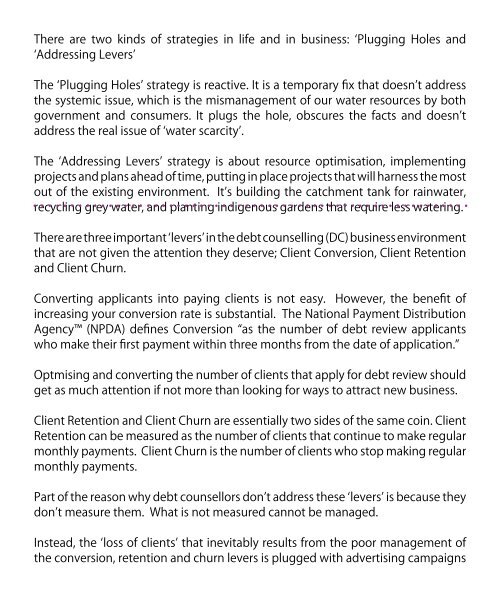Debtfree Magazine October 2016
SA's FREE Debt Counselling and Debt Review industry magazine. What happens if you miss a debt review payment? Find out in this issue (also we have news, reviews, announcements, job opportunities and more)
SA's FREE Debt Counselling and Debt Review industry magazine. What happens if you miss a debt review payment? Find out in this issue (also we have news, reviews, announcements, job opportunities and more)
Create successful ePaper yourself
Turn your PDF publications into a flip-book with our unique Google optimized e-Paper software.
There are two kinds of strategies in life and in business: ‘Plugging Holes and<br />
‘Addressing Levers’<br />
The ‘Plugging Holes’ strategy is reactive. It is a temporary fix that doesn’t address<br />
the systemic issue, which is the mismanagement of our water resources by both<br />
government and consumers. It plugs the hole, obscures the facts and doesn’t<br />
address the real issue of ‘water scarcity’.<br />
The ‘Addressing Levers’ strategy is about resource optimisation, implementing<br />
projects and plans ahead of time, putting in place projects that will harness the most<br />
out of the existing environment. It’s building the catchment tank for rainwater,<br />
recycling grey water, and planting indigenous gardens that require less watering.<br />
There are three important ‘levers’ in the debt counselling (DC) business environment<br />
that are not given the attention they deserve; Client Conversion, Client Retention<br />
and Client Churn.<br />
Converting applicants into paying clients is not easy. However, the benefit of<br />
increasing your conversion rate is substantial. The National Payment Distribution<br />
Agency (NPDA) defines Conversion “as the number of debt review applicants<br />
who make their first payment within three months from the date of application.”<br />
Optmising and converting the number of clients that apply for debt review should<br />
get as much attention if not more than looking for ways to attract new business.<br />
Client Retention and Client Churn are essentially two sides of the same coin. Client<br />
Retention can be measured as the number of clients that continue to make regular<br />
monthly payments. Client Churn is the number of clients who stop making regular<br />
monthly payments.<br />
Part of the reason why debt counsellors don’t address these ‘levers’ is because they<br />
don’t measure them. What is not measured cannot be managed.<br />
Instead, the ‘loss of clients’ that inevitably results from the poor management of<br />
the conversion, retention and churn levers is plugged with advertising campaigns


















